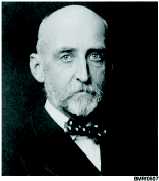David D. Porter (son of the captain of the Essex),
who commanded the mortar flotilla in the
capture of New Orleans
POST CIVIL WAR NAVY
Alfred T. Mahan (fig. 5-7) was one of the first
instructors at the Naval War College, and he influenced
naval strategy. In 1890, the first of his many books and
articles on sea power was published. One of his books
(The Influence of Sea Power Upon History, 1660 - 1783)
stressed that without control of the seas, a nation at war
could not expect victory. He defined sea power; showed
the importance of understanding naval needs; and
advocated a large, powerful Navy capable of assembling
an overwhelming force to defeat the enemy’s Navy. His
books on sea power became the “bible” of many navies,
and for many years, they influenced the thinking of naval
strategists. Part of our Navy’s readiness for the war with
Spain was a result of the influence of his works.
Surface Ships
Steam power was the major development in ship
propulsion during the first half of the 19th century. Iron
construction of ships was the outstanding development
of the second half. The two developments went hand in
hand—all the navies of the world recognized the
advantages of steam power, and iron warships needed
large steam engines to power them. The engines, in turn,
called for bigger ships to accommodate them.
Shipbuilders used iron first as framing and then as a
material for the entire ship. Iron was first used as
framing to reinforce ships so that they could be used to
ram their opponents as well as fire on them. It was
several years before an economical way to process iron
strong enough for the entire construction could be
found. (Wooden ships had the advantage of being
cheaper to build than iron ships.)
After the Civil War, the Navy began a drawdown
period. A year and a half after the war, the total number
of Navy ships was 236, with only 56 in active service.
World conditions made our Country aware that the
Navy was small. Therefore, in 1882 and 1883, Congress
authorized the construction of the “protected cruisers”
USS Atlanta, USS Boston, and USS Chicago and the
dispatch boat USS Dolphin, which had both masts for
sails and stacks for smoke. They were steel hulled and
signaled the end of the ironclads introduced only
40 years earlier. These new cruisers were in the 13- to
14-knot class. They sported new guns, new types of
turrets, and armor.
Once more, the Navy began to rebuild its strength.
Continued changes were made as the new steel Navy
took on new shapes. Still clinging to the past, the USS
Newark, a 4,098-ton protected cruiser, was the last of the
Navy’s warships to be fitted with sails. It was launched in
1890 and commissioned the following year. Because of
its many improvements, the USS Newark has been
labeled as the first modern cruiser in the U.S. Fleet.
With the development of the self-propelled torpedo,
long-range torpedo boats made their debut. In 1890, one
of the first torpedo boats joined the fleet—the 22.5-knot
USS Cushing. The Navy acquired 16 fast torpedo boats
and three 185-ton boats capable of speeds of 27 knots.
The development of torpedo boats caused the shape
of ships to change. An example was the USS Truxtun,
which led to the design of our present-day destroyers.
These ships were designed to combat torpedo boats.
Later improvements resulted in destroyers themselves
carrying torpedoes.
Subsurface Ships
Since surface ships were driven by steam, why not
submarines? Steam requires air, fire, and heat, and those
were in limited supply aboard a submarine. During the
19th century, the internal combustion engine was
developed. Use of this engine on ships had drawbacks.
5-10
Student Notes:
Figure 5-7.—A philosopher of naval strategy, Mahan
researched military history and proved that the nation
controlling the oceans is the nation that maintains its
supremacy in war or peace.


